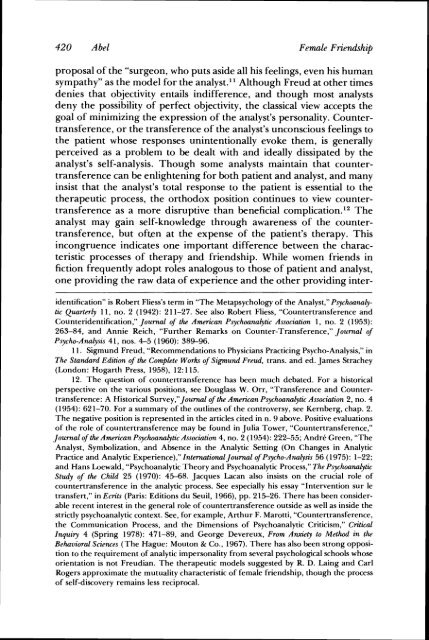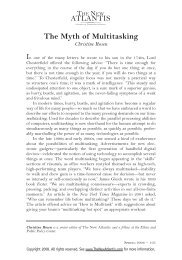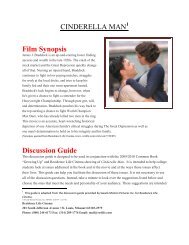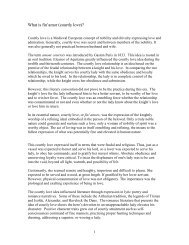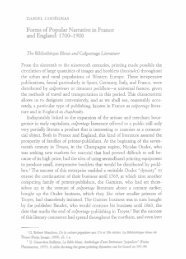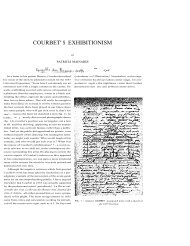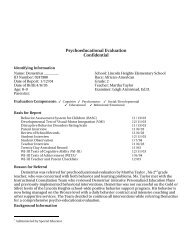(E)Merging Identities: The Dynamics of Female Friendship in ...
(E)Merging Identities: The Dynamics of Female Friendship in ...
(E)Merging Identities: The Dynamics of Female Friendship in ...
Create successful ePaper yourself
Turn your PDF publications into a flip-book with our unique Google optimized e-Paper software.
420 Abel <strong>Female</strong> <strong>Friendship</strong><br />
proposal <strong>of</strong> the "surgeon, who puts aside all his feel<strong>in</strong>gs, even his human<br />
sympathy" as the model for the analyst." Although Freud at other times<br />
denies that objectivity entails <strong>in</strong>difference, and though most analysts<br />
deny the possibility <strong>of</strong> perfect objectivity, the classical view accepts the<br />
goal <strong>of</strong> m<strong>in</strong>imiz<strong>in</strong>g the expression <strong>of</strong> the analyst's personality. Countertransference,<br />
or the transference <strong>of</strong> the analyst's unconscious feel<strong>in</strong>gs to<br />
the patient whose responses un<strong>in</strong>tentionally evoke them, is generally<br />
perceived as a problem to be dealt with and ideally dissipated by the<br />
analyst's self-analysis. Though some analysts ma<strong>in</strong>ta<strong>in</strong> that countertransference<br />
can be enlighten<strong>in</strong>g for both patient and analyst, and many<br />
<strong>in</strong>sist that the analyst's total response to the patient is essential to the<br />
therapeutic process, the orthodox position cont<strong>in</strong>ues to view countertransference<br />
as a more disruptive than beneficial c~mplication.'~ <strong>The</strong><br />
analyst may ga<strong>in</strong> self-knowledge through awareness <strong>of</strong> the countertransference,<br />
but <strong>of</strong>ten at the expense <strong>of</strong> the patient's therapy. This<br />
<strong>in</strong>congruence <strong>in</strong>dicates one important difference between the characteristic<br />
processes <strong>of</strong> therapy and friendship. While women friends <strong>in</strong><br />
fiction frequently adopt roles analogous to those <strong>of</strong> patient and analyst,<br />
one provid<strong>in</strong>g the raw data <strong>of</strong> experience and the other provid<strong>in</strong>g <strong>in</strong>ter-<br />
identification" is Robert Fliess's term <strong>in</strong> "<strong>The</strong> Metapsychology <strong>of</strong> the Analyst," Psychoanalytic<br />
Quarterly 11, no. 2 (1942): 21 1-27. See also Robert Fliess, "Countertransference and<br />
Counteridentification,"Journal <strong>of</strong> the American Psychoanalytic Association 1, no. 2 (1953):<br />
263-84, and Annie Reich, "Further Remarks on Counter-Transference," Journal <strong>of</strong><br />
Psycho-Anulyszs 41, nos. L 5 (1960): 38S96.<br />
11. Sigmund Freud, "Recommendations to Physicians Practic<strong>in</strong>g Psycho-Analysis," <strong>in</strong><br />
<strong>The</strong> Standard Edition <strong>of</strong> the Complete Works <strong>of</strong> Sigmund Freud, trans. and ed. James Strachey<br />
(London: Hogarth Press, 1958), 12: 1 15.<br />
12. <strong>The</strong> question <strong>of</strong> countertransference has been much debated. For a historical<br />
perspective on the various positions, see Douglass W. Orr, "Transference and Countertransference:<br />
A Historical Survey," Journal <strong>of</strong> the American Psychoanalytic Association 2, no. 4<br />
(1954): 621-70. For a summary <strong>of</strong> the outl<strong>in</strong>es <strong>of</strong> the controversy, see Kernberg, chap. 2.<br />
<strong>The</strong> negative position is represented <strong>in</strong> the articles cited <strong>in</strong> n. 9 above. Positive evaluations<br />
<strong>of</strong> the role <strong>of</strong> countertransference may be found <strong>in</strong> Julia Tower, "Countertransference,"<br />
Journal <strong>of</strong> the American Psychoanalytic Association 4, no. 2 (1954): 222-55; Andri. Green, "<strong>The</strong><br />
Analyst, Symbolization, and Absence <strong>in</strong> the Analytic Sett<strong>in</strong>g (On Changes <strong>in</strong> Analytic<br />
Practice and Analytic Experience)," International Journal <strong>of</strong> Psycho-Analysis 56 (1 975): 1-22;<br />
and Hans Loewald, "Psychoanalytic <strong>The</strong>ory and Psychoanalytic Process," <strong>The</strong> Psychoanalytic<br />
Study <strong>of</strong> the Child 25 (1970): 45-68. Jacques Lacan also <strong>in</strong>sists on the crucial role <strong>of</strong><br />
countertransference <strong>in</strong> the analytic process. See especially his essay "Intervention sur le<br />
transfert," <strong>in</strong> Ecrits (Paris: Editions du Seuil, 1966), pp. 215-26. <strong>The</strong>re has been considerable<br />
recent <strong>in</strong>terest <strong>in</strong> the general role <strong>of</strong> countertransference outside as well as <strong>in</strong>side the<br />
strictly psychoanalytic context. See, for example, Arthur F. Marotti, "Countertransference,<br />
the Communication Process, and the Dimensions <strong>of</strong> Psychoanalytic Criticism," Critical<br />
Inquzq 4 (Spr<strong>in</strong>g 1978): 471-89, and George Devereux, From Anxiety to Method <strong>in</strong> the<br />
Behavioral Sczences (<strong>The</strong> Hague: Mouton & Co., 1967). <strong>The</strong>re has also been strong opposition<br />
to the requirement <strong>of</strong> analytic impersonality from several psychological schools whose<br />
orientation is not Freudian. <strong>The</strong> therapeutic models suggested by R. D. La<strong>in</strong>g and Carl<br />
Rogers approximate the mutuality characteristic <strong>of</strong> female friendship, though the process<br />
<strong>of</strong> self-discovery rema<strong>in</strong>s less reciprocal.


